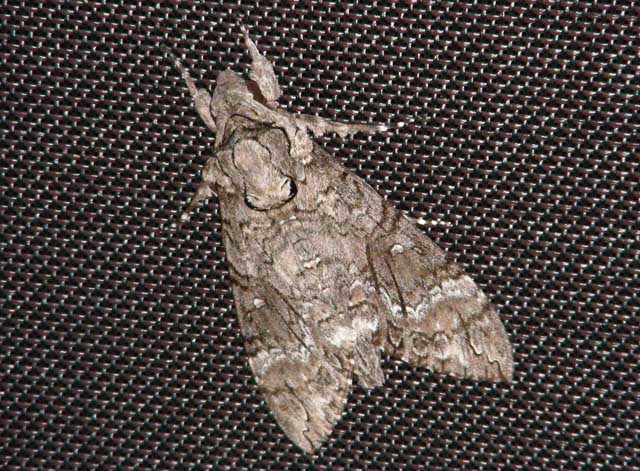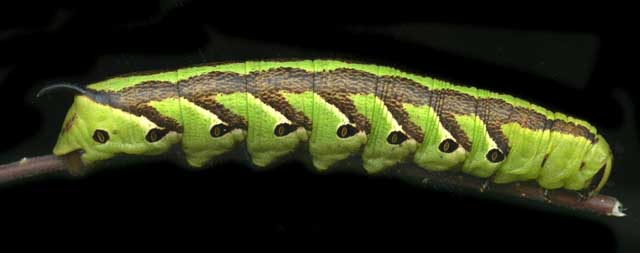Agrius cingulata
Agrius cingulata
ah-GREE-usmm sin-gue-LAY-ta
The Pink-spotted Hawkmoth
(Fabricius, 1775) Sphinx

Agrius cingulata, Dallas, Collin County, Texas,
October 8, 2010, courtesy of Robert McClure.

sweet potato, pool side, Dallas, Collin County, Texas,
October 16, 2010, courtesy of Robert McClure.
Robert writes, October 16, regarding the sighting of Agrius cingulata on his window screen,
"We planted sweet potato vines as a border to our pool this past year, and the vines have gone crazy creating a very pretty border of lush foliage around
the pool, and obviously a home for the moth! Attached is one more picture showing the sweet potato vines that added such beautiful greenery to the pool
area. No wonder that this creature found itself at home and happy in our backyard. The screen on the window in the previous pictures is on the directly
opposite side of the pool."
It is possible that the larva did indeed feed on the lush foliage of the sweet potato vines earlier in the summer. It is also possible that
the moth flew in from a more remote locale. The adult moths fly and feed at night, nectaring from flowers that remain open after dark.
Almost all moths are attracted to lights, and the light coming from inside the house or a night light from near the window screen probably lured
the moth to its perch.
If you have a combination of adult nectar sources and larval food plants, you will probably attract a great variety of Sphingidae. Many of these adult
moths are especially attracted to moon flowers and phlox which provide nectar at night. Larvae of some local Texas species species feed on tomato and
pepper foliage, others on mint or
sage (Lintneria species), some on pentas (Xylophanes tersa), some on
lilac, passionflower, honeysuckle, juniper, grape, Virginia creeper (Eumorpha species), portulaca, primrose, fuschia, etc., all of which are often
planted in yards for their
produce or appearance.
Some of the day flyers, (Hemaris, species are especially fond of nectaring from butterfly bush.
Sometimes the larvae are regarded as pests, as they can reach considerable size and consume large amounts of foliage. The tomato feeders (Manduca sexta,
Manduca quinquemaculatus) can make a mess
of your tomato plants, and once all the foliage is gone, they have been known to munch on the green fruit. So be careful what you plan for.
Larvae of most Sphingidae species have an anal horn which looks menacing, but I do not know of any North American Sphingidae species whose larvae
pose any kind of threat to humans, other than the distress of seeing your plant foliage disappear!
Just by coincidence, on October 16, 2010, David Bygott provided me with a beautiful image of an Agrius cingulata larva that I had identified for him.
It is quite remarkable how these larvae are well camouflaged in the foliage upon which they feed.
In this case the brown subdorsal line on the larva is almost the same colour and thickness as the foliage stem. The green colouration of the larva is
probably a good match for the foliage, and the dark, oblique lines on the larva's side, probably match the angle at which branches or leaf stems
would emanate from the main stem.
This larva can exceed four inches in length. In most cases, the lush, abundant foliage of the sweet potato vine keeps it both well fed and hidden.

Agrius cingulata green form (there is also a brown form), courtesy of David Bygott.
Use your browser "Back" button to return to the previous page.
This page is brought to you by
Bill Oehlke and the
WLSS. Pages are on space rented from Bizland. If you would like
to become a "Patron of the Sphingidae Site", contact Bill.
Please send sightings/images to Bill. I will do my best to respond to
requests for identification help.


